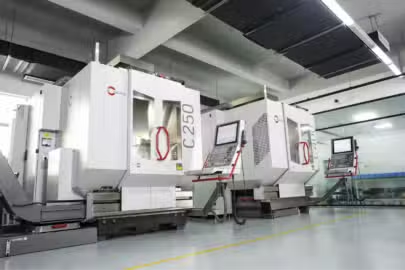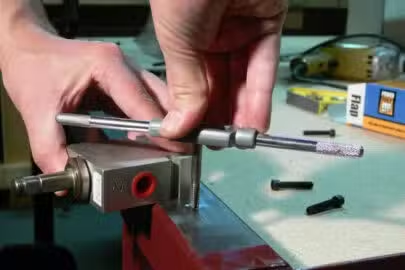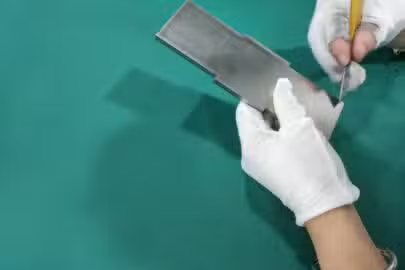Due to its precision and consistency, CNC machining has taken over the manufacturing scene. Understanding the fundamentals of CNC technologies is critical to identifying their features. CNC turning is one example of such innovation.
Using a non-spinning cutting tool on a turning center or lathe, this method removes material from a rotating, robust workpiece. CNC turning can produce components of various forms and sizes depending on the turning procedure.
While the principle may appear simple, obtaining top-notch CNC turning can be difficult. If you’re interested in learning more about the CNC turning process and how to attain the best outcomes, this article will answer all of your questions.
What Is CNC Turning?

CNC turning is a precise and efficient subtractive machining technology based on the lathe machine idea. The cutting tool meets a rotating workpiece, removes material, and sculpts the required shape.
During this procedure, the turning center or lathe remains stationary while the raw material spins fast. The material is sculpted with a single-point cutting tool that is synchronized with a dual-axis movement in the CNC turning machine. Computer programs take over, supervising the turning center or lathe and ensuring the production of precisely exact components.
It is easy to mix up CNC turning with milling, but they’re distinct. CNC milling and other subtractive processes often secure the workpiece to a bed, with a spinning tool cutting the material. CNC turning, however, flips the script—rotating the workpiece while keeping the cutting bit stationary.
What Part Shapes Need CNC Turning?

CNC turning specializes in crafting cylindrical or oblong components due to its operational style. Yet, it’s not limited to just that—it can also fashion shapes with axial symmetries. Picture cones, disks, or a mix of various shapes. And here’s the cool part: certain turning centers go the extra mile, executing polygonal turning operations with special rotating tools. This means you can whip up components in funky shapes like hexagons or squares. The versatility is pretty impressive!
Merits of CNC Turning
There are numerous advantages of CNC turning which include:
- Accuracy
The CNC turning machine takes precision to the next level by executing exact measurements and eradicating human errors through CAD or CAM files. Experts achieve remarkable accuracy with state-of-the-art machinery, be it for prototyping or completing the entire production cycle. The beauty of it lies in the precision of each cut, thanks to the machine’s programmed instructions. Essentially, the final piece in the production run mirrors the first piece identically.
- Flexibility
Turning centers offer flexibility in various sizes to suit your applications. Adjustments are a breeze since the machine’s tasks are preprogrammed. Operators can complete your component by tweaking the programming in your CAM program or even venture into creating something entirely new. This means you can count on the same precision CNC machining services company for a variety of unique parts. It’s like having a versatile toolkit at your disposal!
- Safety
Safety is a top priority in manufacturing firms, with strict adherence to rules and regulations ensuring complete safety. Thanks to the automatic nature of the turning machine, less manual labor is needed; operators mainly monitor the machine. The lathe body is equipped with fully enclosed or semi-enclosed protective devices, preventing flying particles from the processed item and reducing the risk of harm to the crew. It’s a double layer of safety to keep things running smoothly.
- Faster Results
The likelihood of errors decreases significantly when tasks are programmed for CNC lathes or turning centers. This efficiency allows the machine to wrap up production faster without compromising the quality of the final output. In the end, you get your necessary components quicker compared to other options. It’s like a shortcut to precision and speed in the manufacturing game.
How Does CNC Turning Work?

Although knowing how CNC turning works may seems a daunting task, we will help you understand it by breaking it down into various steps as shown below:
The general steps of CNC turning are:
- Convert the CAD Design File to the CNC Program
The first phase begins with preparing a CAD file for conversion into the CNC turning machine’s language. There is no need for complicated programming in this case. If you have 2D drawings of your design, digitize them with tools like AutoCAD or SolidWorks.
Converting an electronic design in the CAD file format into a CAM program is the next step. To export the drawing in CAM format, use the same software tools that were stated earlier. The manufacturing engineer can then utilize the program to examine the component’s manufacturability. It’s like giving your idea a digital thumbs-up before it hits the assembly line.
- Prepare the CNC Turning Machine
Moving on to the next phase: machine setup. Despite the automation, an operator plays a crucial role in preparing the CNC turning lathe. Here’s a step-by-step guide:
i. Power Off: Safety first. Ensure the power is off, given the potential hazards of CNC machining. Check and double-check those power switches.
ii. Secure the Part: Properly load and secure the part onto the chuck, responsible for holding it in place during turning. Incorrect loading can be hazardous and lead to components with incorrect dimensions.
iii. Load the Tool Turret: Multiple tools are part of the turning process. Select the right tool for your finish, and the turret holds several tools simultaneously, ensuring a smooth operation.
iv. Calibration: Achieve proper calibration by setting the tool and workpiece correctly. This ensures the result meets the required standards.
v. Upload CNC Program: Before kicking off the operation, upload the CNC code into the machine.
At this stage, consider two critical variables: turning speed (the workpiece’s rotation speed) and feed rate (the cutting tool’s speed along the rotating workpiece).
A seasoned machinist determines these values, as inaccuracies can impact the final results. Improper estimations, especially with certain materials, could lead to uneven finishes or irreparable damage to the workpiece.
For a rough shape, opt for a low turning speed and a high feed rate. For smooth finishes and parts with precise tolerance requirements, go for a high turning speed and a lower feed rate. It’s all about finding the right balance for the best outcome.
- Produce the CNC Turned Parts
The final leg of the journey is bringing your envisioned part to life. Various turning operations are at your disposal, each tailored to the specific result you seek. The part’s complexity dictates the number of cycles required, and calculating the cycle time becomes essential for cost estimation.
Typically, turning cycle time includes:
- Loading Time: While part of the setup, a cycle might involve additional loading of the workpiece onto the machinery.
- Cutting Time: This is the duration it takes to cut the workpiece. Factors like feed rate and cutting depth influence the cutting time.
- Idle Time: Any operation not involving cutting falls into the idle category. Examples include adjusting the settings of the turning center and tool movement.
The outcome of the manufacturing process hinges on the chosen raw material. A component crafted from plastic will differ in functionality and surface roughness compared to a metal counterpart. So, the material choice plays a pivotal role in determining the final characteristics of your product.
Types of CNC Turning Operations

The field of CNC turning provides a wide range of lathe tools, allowing for a wide range of operations on a workpiece. These operations are classified into two types: external and internal. External operations aim to change the outward diameter of the component, whereas internal operations aim to change the interior diameter.
The cutting tool used and the path taken to remove materials govern the characteristics of each operation. Let’s dive into the diverse operations available in CNC turning.
Turning Specific Operations (External)
i. Turning
In the turning process, a single-point turning tool glides along the side of the workpiece, systematically removing materials to create various features. These features encompass tapers, chamfers, steps, and contours. Typically, the machining of these features involves working at small radial depths of cut, necessitating multiple passes to reach the final diameter.
Moreover, tapered turning within this process entails the gradual reduction or increase of the diameter of a cylindrical workpiece, resulting in the production of conical surfaces. This technique allows for the precise shaping of components with varying diameters.
ii. Hard Turning
Hard turning is reserved for materials with a Rockwell C hardness greater than 45, requiring crucial heat treatment before the process. It aims to limit or replace traditional grinding operations, offering a competitive edge in stock removal. However, it may not be the go-to for operations where precision in dimension and form is critical.
iii. Facing
Face turning cuts a flat surface perpendicular to the workpiece’s rotational axis. The tool, mounted on a tool holder resting on the lathe carriage, feeds perpendicularly across the rotational axis. This versatile process can be performed as a roughing cut or as a final pass cut, giving you flexibility in achieving the desired surface.
iv. Grooving
In this operation, a single-point turning tool makes a radial movement into the workpiece’s side, cutting a groove with equal width to the cutting tool. Multiple cuts can be made to form larger grooves than the tool width. Some manufacturers even use special tools to craft grooves with varying geometries, adding a touch of customization to the process.
v. Parting
Similar to grooving, the cutting tool moves radially into the workpiece’s side until it reaches the inner diameter or center. The single-point tool continues until it parts or cuts off a section of the raw material. It’s like precision surgery for your workpiece, separating it with accuracy.
Non-Specific Operations (Internal)
i. Boring
Boring tools venture into the workpiece to cut along the internal surface, shaping features like tapers, chamfers, steps, and contours. The adjustable boring head allows you to set the tool to cut the desired diameter. Performing boring operations after drilling a hole can enhance precision, ensuring more accurate dimensions.
ii. Drilling
For creating a hole on the rotational axis of the part, a drill is employed. In advanced turning centers, holes can be drilled in various orientations, not limited to the central axis. It’s a fundamental yet crucial step in the machining process.
iii. Threading
Threading utilizes a single-point threading tool with a 60-degree pointed nose, moving axially along the workpiece side to cut threads into the outer surface. Machinists can cut threads to specified lengths, and some threads may require multiple passes for precision.
iv. Knurling
Knurling involves cutting serrated patterns onto the workpiece’s surface using a specialized knurling tool. This pattern serves both as a visual enhancement and a practical hand grip, adding texture and functionality to the component.
v. Reaming
This sizing operation removes small amounts of metal from an already drilled hole, ensuring internal holes have exact diameters. It’s a precision step, refining the dimensions of the hole. For example, if you’ve drilled a 6mm hole with a 5.98mm drill bit, reaming brings it to the accurate dimension.
Types of CNC Turning Machines
You can use four major types of CNC turning machines for your project. They include:
- Horizontal Turning Centers
Enclosed machines that bring together drilling and milling capabilities. These centers utilize a horizontally oriented spindle and tools mounted above the rotating workpiece. Cutting tools traverse the material, using gravity to pull chips away similar to milling. Chips conveniently move down into the bed for easier removal.
- Vertical Turning Centers
Combining a horizontal turning center with a CNC mill, this design places the rotating chuck flat on the ground. This setup allows for machining large pieces at lower RPMs, with the tool turret approaching from the side. Inverted vertical turning centers exist, where the spindle and chuck are in reversed positions, offering versatility in machining orientations.
- Horizontal Lathes
These lathes retain all the features of a conventional lathe but are controlled by computer programs. Their primary operations include turning and boring, providing precision and efficiency in machining processes.
- Vertical Lathes
In contrast to horizontal lathes, vertical lathes secure the workpiece from the bottom before spinning it. This is an excellent option for machine shops with limited space and proves ideal for working on heavy workpieces. The vertical setup adds flexibility to machining practices, adapting to different spatial and weight requirements.
Components of CNC Turning Machine
A thorough understanding of the machine tool is required to achieve the greatest outcomes from a turning technique. Let’s have a look at the major parts of a CNC turning center.
- Headstock
The front part of a turning center, usually on the left side, houses the main spindle where the chuck attaches to hold the workpiece. It contains the driving motor and mechanisms for powering the spindle, and the spindle bar’s capacity determines the maximum workpiece diameter.
- Tailstock
Situated at the opposite end of the turning center, attached to the lathe bed, supporting longer raw materials. The tailstock provides support using hydraulic force and runs along with the workpiece. It is avoided when face turning is crucial.
- Spindle
Considered the heart of the machine tool, the main spindle consists of a spindle drive system and a spindle assembly, with moving parts like motors, gears, and chuck. Some turning centers feature a sub-spindle or dual spindle for enhanced machining capabilities.
- Chuck and Collet
The chuck holds the part with its jaws, attaching directly to the spindle, and is replaceable for machining different-sized parts. Collets, smaller versions of chucks, allow the machining of smaller parts and provide better grips for pieces around 60 mm in size.
- Lathe Bed
Made of cast iron, the bed serves as the base plate under the workspace, supporting fixed and operational parts. It connects the headstock to the tailstock, and the tool turret and other attachments run along its length.
- Carriage
Supports the tool turret, guiding it against the workpiece. The carriage includes the turret, saddle, and cross-slide. CNC turning centers with live tool turrets have powered rotary tools for milling operations, enhancing functionality, and reducing or eliminating secondary operations.
- Tool Turret
An improvement over the carriage, modern machines feature a tool turret that can hold multiple tools simultaneously, allowing quick changes between cutting tools for different operations without downtime.
- Control Panel
The brain of CNC turning operations, where the computer numerical control resides. The control panel enables operators to adjust programs before initiating the machining process, providing precision and flexibility in operation.
Appropriate Material for CNC Turning
The choice of materials for CNC machining, including CNC turning, is diverse. Here’s a breakdown of some commonly used materials:
- Metals: Ideal for a range of applications, metals like aluminum, steel, brass, and titanium are frequently used in CNC turning operations. Each metal has its unique properties, making it suitable for various requirements.
- Plastics: Materials like ABS, acrylic, nylon, and PTFE are commonly used in CNC turning for their versatility, lightweight nature, and ease of machining.
- Wood: CNC turning isn’t limited to metals and plastics; it extends to wood as well. Wood materials like oak, maple, and walnut can be shaped and carved with precision using CNC turning.
- Glass: While glass may not be as common as other materials, it’s feasible for certain CNC turning applications. Precision and careful machining are essential when working with glass.
- Wax: Often used for prototyping, wax is a material that can be easily machined in CNC turning processes. It’s particularly useful for creating intricate and detailed prototypes before moving to the final material.
Each of these materials requires specific considerations in terms of turning speed, feed rate, and tooling. The versatility of CNC turning lies in its ability to adapt to different materials, providing a wide range of options for various manufacturing needs.
Conclusion
CNC turning is crucial in the manufacturing business, providing precision and versatility for a wide range of components. The discussion in this article on its many characteristics and distinct benefits provides helpful insights for making educated project decisions.
If you need additional professional guidance on CNC turning or support with your manufacturing needs, contacting specialists like Zintillion’s CNC machining is a wise decision. They can give the skills and support needed to guarantee that your projects are completed with efficiency and precision.




